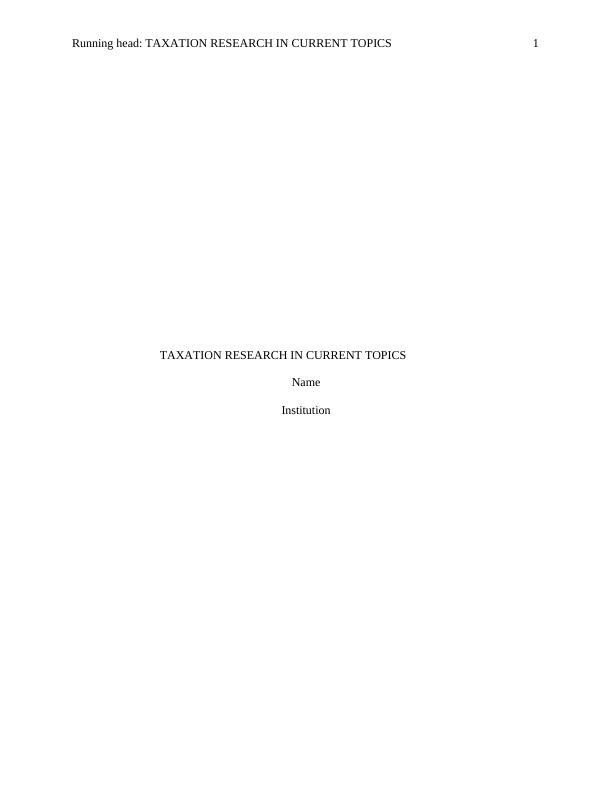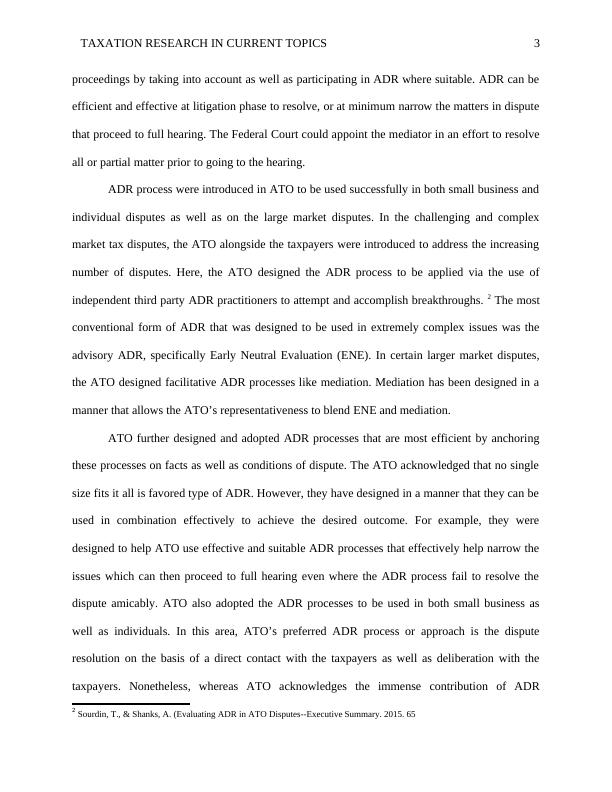Ask a question from expert
Alternative Dispute Resolution Assignment
14 Pages4144 Words484 Views
Added on 2020-04-29
Alternative Dispute Resolution Assignment
Added on 2020-04-29
BookmarkShareRelated Documents
Running head: TAXATION RESEARCH IN CURRENT TOPICS 1TAXATION RESEARCH IN CURRENT TOPICSNameInstitution

TAXATION RESEARCH IN CURRENT TOPICS 2TAXATION RESEARCH IN CURRENT TOPICS: ADRQ1: When and Why ATO Adopted ADRThe ADR (Alternative Dispute Resolution) describes an inclusive term for all the processexcept the tribunal or judicial determination whereby an impartial individual (ADR practitioner/ATO representative) helps the parties in dispute to resolve or narrow the matters in theunderlying dispute between parties. The ATO introduced and adopted the ADR in settlingdisputes in 2013. These were introduced to bar disputes at the earliest stage in dispute processthat remain of benefit to both taxpayer and ATO. The aim of ADR was to resolve disputes pittingtaxpayers and ATO in a swift and cost-efficient way. The ADR was designed to accomplishvarious varying results including dispute settlements partially or fully, issues narrowing,evidence and facts clarification, and constructive relationship nurturing or development. 1The ADR processes have remained imperative and integral part of the ATO’s approach tomanagement and resolution of the dispute following the taxpayers’ disagreement with ATO.Even though a great proportion of the interactions of the ATO fails to end up in the dispute, ATOuses the ADR process to resolve the disputes as early as feasible, while at the same time, makingsure that ATO treats its taxpayers fairly as well as in a consistent manner that meets theexpectation of the parties engaging in the ADR process. The ATO has been using ADR to reducethe time taken for dispute resolution, reduction of dispute quantities, lower costs for both ATOand taxpayers as well as making interactions with ATO easier.The ADR process were also adopted to be used in appeal cases that were beingincreasingly filed with Federal Court or ATT. This remains in line with the obligation of theATO as a model litigant, to endeavor wherever feasible to evade, bar and restrain scope of legal1Bentley, D. (Problem resolution: does the ATO approach really work)?. Revenue Law Journal, 6(1), 3. 1996. 54

TAXATION RESEARCH IN CURRENT TOPICS 3proceedings by taking into account as well as participating in ADR where suitable. ADR can beefficient and effective at litigation phase to resolve, or at minimum narrow the matters in disputethat proceed to full hearing. The Federal Court could appoint the mediator in an effort to resolveall or partial matter prior to going to the hearing. ADR process were introduced in ATO to be used successfully in both small business andindividual disputes as well as on the large market disputes. In the challenging and complexmarket tax disputes, the ATO alongside the taxpayers were introduced to address the increasingnumber of disputes. Here, the ATO designed the ADR process to be applied via the use ofindependent third party ADR practitioners to attempt and accomplish breakthroughs. 2 The mostconventional form of ADR that was designed to be used in extremely complex issues was theadvisory ADR, specifically Early Neutral Evaluation (ENE). In certain larger market disputes,the ATO designed facilitative ADR processes like mediation. Mediation has been designed in amanner that allows the ATO’s representativeness to blend ENE and mediation. ATO further designed and adopted ADR processes that are most efficient by anchoringthese processes on facts as well as conditions of dispute. The ATO acknowledged that no singlesize fits it all is favored type of ADR. However, they have designed in a manner that they can beused in combination effectively to achieve the desired outcome. For example, they weredesigned to help ATO use effective and suitable ADR processes that effectively help narrow theissues which can then proceed to full hearing even where the ADR process fail to resolve thedispute amicably. ATO also adopted the ADR processes to be used in both small business aswell as individuals. In this area, ATO’s preferred ADR process or approach is the disputeresolution on the basis of a direct contact with the taxpayers as well as deliberation with thetaxpayers. Nonetheless, whereas ATO acknowledges the immense contribution of ADR2Sourdin, T., & Shanks, A. (Evaluating ADR in ATO Disputes--Executive Summary. 2015. 65

TAXATION RESEARCH IN CURRENT TOPICS 4processes, the Tax Office remains alive to the fact that ADR will always not be suitable in somecases. However, ATO still uses ADR process like facilitative ADR to speak to such cases.Q2: ADR ProcessesThe various ADR processes include conciliation, early neutral evaluation and mediationand in-house facilitation. The ADR process have the following characteristics. In facilitativeprocess whereby the ADR practitioner helps the parties in the identification of the issuesdisputed, developing alternatives, considering options and endeavoring to arrive at consensusregarding certain issues/matters or the entire of dispute. In Advisory Processes in which the ADR practitioner considers as well as appraises thedispute and move ahead to issue advice on certain or all of the dispute facts, the law, as well asfeasible or desirable results. 3 In determinative processes, the ADR practitioner undertakes theevaluation of the dispute and moves ahead to make a determination. The determinative processeslike arbitration, are never generally suitable for the ATO disputes and, hence are neverconsidered further. In blended dispute resolution processes, an ADR practitioner has multipleroles and responsibilities like, in conciliation and conferencing, he/she could facilitatedeliberations and provide advice on the dispute’s merits. Facilitative Processes (i) Mediation This is the process in which that parties to a dispute negotiate with the help of theimpartial ADR practitioner helping the parties with in identifying the issues disputed, developingoptions, considering options as well as trying to strike an agreement. The mediators in mediationdo not often provide advice, except the parties have requested evaluative or advisory conciliation3Bentley, D. (A Model of Taxpayers' Rights as a Guide to Best Practice in Tax Administration). 2006.

End of preview
Want to access all the pages? Upload your documents or become a member.
Related Documents
Understanding Alternative Dispute Resolution in England and Waleslg...
|12
|2910
|385
Family Matters Or Business Affairslg...
|9
|3236
|10